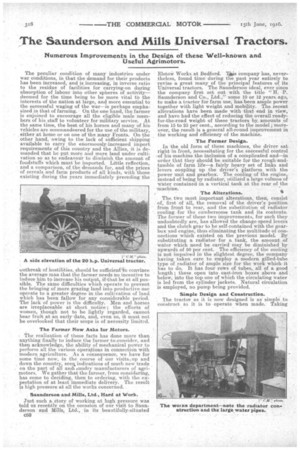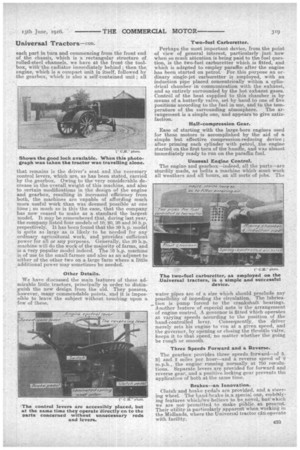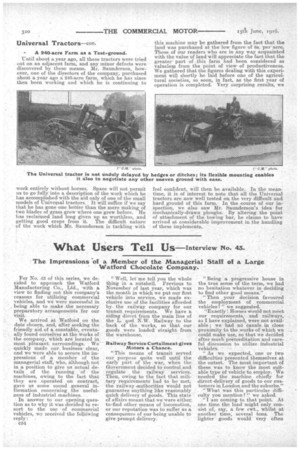The Saunderson and Mills Universal Tractors.
Page 14

Page 15

Page 16

If you've noticed an error in this article please click here to report it so we can fix it.
Numerous Improvements in the Design of these Well-knbwn and Useful Agrimotors.
The peculiar condition of many industries under war conditions, in that the demand for their products has been increased, and is increasing, in inverse ratio to the residue of facilities for carrying-on during absorption of labour into other spheres of activity— deemed for the time being to be more vital to the interests of the nation at large, and more essential to the successful waging of the war—is perhaps emphasized in that of farming.. On the one hand, the farmer is enjoined to encourage all the eligible male members of his, staff to volunteer for military service. At the same time, the best of his horses and many of his vehicles are oommandeered for the use of the military, either at home or on one of the many Fronts. On the other hand, owing to the lack of sufficient shipping available to carry the efiormously-increased import requirements of this country and the Allies, it is demanded that he put more and more land under cultivation so as to endeavour to diminish the amount of foodstuffs which must be imported: Little reflection, and a comparison, of the .demands for, and the prices of cereals and farm products of all kinds, with those existing during the years immediately preceding the uutbreak of hostilities, should be sufficient to convince the average man that the farmer needs no incentive to induce him to increase his output, ifithat be at all possible. The same difficulties which operate to prev.ent the bringing of more grazing land into productive use operate to a greater degree in the cultivation of land which has been fallow for any considerable period. The lack of power is the difficulty. Men and horses are irreplaceable at short notice-; the efforts of women, though not to be lightly regarded, cannot bear fruit at an early date, and, even so, it must not be o-verlooked that their scope is of necessity limited.
The Farmer Now ,Asks for Motors. •
The realization of these facts has done more than anything finally to induce the farmer tooconsider, and then acknowledge, the ability of mechanical power to perform all the various Operations in connection with modern agriculture. As a consequence, we have for some time now, in the course of our visits, up and down the country, seer. indications of much new trade on the part of all and orndry manufacturers of asrimotors. We gather that the farmer, from considering, has come to deciding, then to ordering, with the expectation of at least immediate delivery. The result is high pressure at all the works concerned.
Saunderson and Mills, Ltd., Hard at Work.
Just such a story of working at high pressure was told. us recently on the occasion of our visit to Saunderson and Mills, Ltd., in its beautifully-situated c50
El-stow Works at Bedford. Tails Company has, nevertheless, found time during the past year entirely to revise a great many of the principal features of its Universal tractors. The Saunderson ideal, ever since the company first set out with the title " H. P. Saunderson -and Co., Ltd.," some 10 or 12 years ago, to make a tractor for farm use, has -been ample power together with light weight and mobility. The recent alterations have been made with that end in view, and have had the effect of reducing the overall readyfor-the-road weight of these tractors by amounts of from 15 to 25 per cent., according to the model ; moreover, the result is a general all-round improvement in the working and efficiency of the raachine.
The Former Design.
In the old form of these machines, the driver sat right•in front, necessitating for the suecessful control of his machine the incision of a complicated and—in order that they should be suitable for the rough-andtumble of farm life—a fairly heavy set of links and levers coupling up the driver's platform with the power unit and gearbox, The cooling of the engine, instead of being by radiator, utilized a large volume of water contained in a •vertical tank at the rear of the -machine.
The Alterations. 4 The, two most important alterations, then, consist of first of all, the removal of the driver's position from front to rear, and the substitution of radiator cooling for the cumbersome tank and its contents. The former of these two improvements, for such they undoubtedly are, has allowed the change-speed levers and the clutch gear to be self-contained with the gearbox and engine, thus eliminating the multitude of connections which existed on the previous' model. By substituting a radiator for a -tank, the amount of water which need be carried may be diminished by upwards of 50 per cent. The efficiency of the cooling is not impaired in the slightest degree, the company having taken care to employ a modern gilled-tube type of radiator of ample size for the work which it has to do. It has four rows of tubes,. all of a good length ; these open into east-iron boxes . above and below, into the top one of which the circulating water is led from the cylinder jackets. Natural circulation is employed, no pump being provided.'
Simple Design and Construction.
The tractor as it is 'now designed is as simple to construct as it is to operate when made. Taking each part in turn and commencing from the front end of the chassis, which is a rectangular structure of rolled-steel channels, we have at the front the tool
box, with radiator immediately behind ; then the. engine, which is a compact unit in itself, followed by the gearbox, which is also a. self-contained unit ; all that remains is the driver's seat and the necessary control levers, which are, as has been stated, 'carried by the gearbox. Owing to the very considerable de• crease in the overall weight of this machine, and also to certain modifications in the design of the engine and gearbox, resulting in increased efficiency from both, the machines are -capable of affording much more useful work than was. deemed possible at one time ; so much so is this-the case, that the company has now ceased to make as a. standard the largest model. It may be remembered that, during last year, the company listed four models of 10, 20, 30 and 50 h.p. respectively. It has been found that the 30 hp. model is quite as large as is likely to be needed for any ordmary agricultural work, and provides sufficient power for all or any purposes. Generally, the 20 h.p. machine will do the work of the majority of farms, and is a Yery popular model indeed. The 10 h.p. machine is of use to the small farmer and also as an adjunct to either of the other two on a large farm where a little additional power may sometimes be needed,
Other Details.
We have discussed the main features of these admirable little tractors, principally in order to distin • guish the new design from the old. They possess, :however, many commendable points, and it is impossible to leave the subject without touching upon a -few of these.
Two-fuel Carburetter.
Perhaps the most important device, from the point of view of general interest, particularly, just how when so much attention is being paid to the fuel question, is the two-fuel carburetter which, is fitted, and which is adapted to employ paraffin after the engine has been started on petrol; F-or this purpose an ordinary single-jet carburetter is employed, with an induction pipe placed concentrically within a cylindrical chamber in communication with the exhaust, and so entirely surrounded by the hot exhaust gases. Control of the heat supplied to this chamber is by means of a butterfly valve, set by hand to one of five positions according to the fuel in use, and to the temperature of the surrounding atmosphere. The arrangement is a simple one, and appears to give satisfaction.
Hall-compression Gear.
Ease of starting with the large-bore engines used for these motors is accomplished by the aid of a simple but effective compression-reducing device;. after priming each cylinder with petrol, the engine started on the first turn of the handle, and was almost immediately ready to run on the paraffin fuel.
Unusual Engine Control.
The engine and gearbox--indeed, all the parts—are sturdily made, as befits a machine which must work all weathers and all hours, on all sorts of jobs. The water pipes are of a size which should preclude any possibility of impeding the circulation. The lubrication is pump forced to the crankshaft bearings. Another feature of especial note is the arrangement • of engine control. A governor is fitted which operates at varying speeds according to the position of the hand-controlled lever. Consequently, the driver merely sets his engine to run at a given speed, and the governor, by opening or closing the throttle valve, keeps it to that speed, no matter whether the going be rough or -smooth.
Three Speeds Forward and a Reverse. _ The gearbox provides three speeds forward—of 5. 81 and 2 miles per hour—and a reverse speed of 2 m.p.h., the engine running normally at 750 revolutions. Separate levers are provided for forward and reversesear; and d positive locking gear prevents the application of both at the same time.
Brakes—an Innovation.
Clutch and brake pedals are provided, and a steering wheel. The hand-larake.is,a special one, embodying features whielifwe believe to beenovel, but'which we are not permitted to make pnblic._ at preSent. Their utility is particularly apparent'whenwbrking in the Midlands, where the Universal tractor can:operate
A 290-acre Farm as a Test-ground.
Until about a year ago, all these tractors were tried out on an adjacent farm, and any minor defects were discovered by these means. Mr. Saiinderson, however, one of the directors of the company, purchased about a year ago a 240,a,cre farm.. which he has since then been working and which he is continuing to work entirely without horses. Space will not permit us to go 'fully into a description of the work which he has accomplished with the aid only of one of the small models of Universal tractors. It will suffice if we say that he has gone one better than the mere making of two blades of grass grow where one grew before. He has reclaimed land long given up as worthless, and getting good crops from it. The difficult nature of the work which Mr. Saunderson is tackling with
this machine may be gathered from the fact that the land was purchased at-the low figure of 8s. per acre. Those of our readers who are in any way acquainted with the value of land will appreciate the fact. that the greater part of this farm had been. considered as valueless from the point of view of productiveness. We gathered that the figures dealing with this experiment will shortly be laid before one of the agricultural societies, so soon, in fact, as the first year of operation is completed. Very surprising results, we
feel confident, will then be available. In the meantime, it is of interest to note that all the Universal tractors ase now well tested on the very difficult and hard ground of this farm. In the course of our inspection, we also saw Mr. Saunderson's idea for Mechanically-drawn ploughs. By altering the point of attachment of the towing bar, he claims to have arrived at considerable improvement insthe handling of these implements.




















